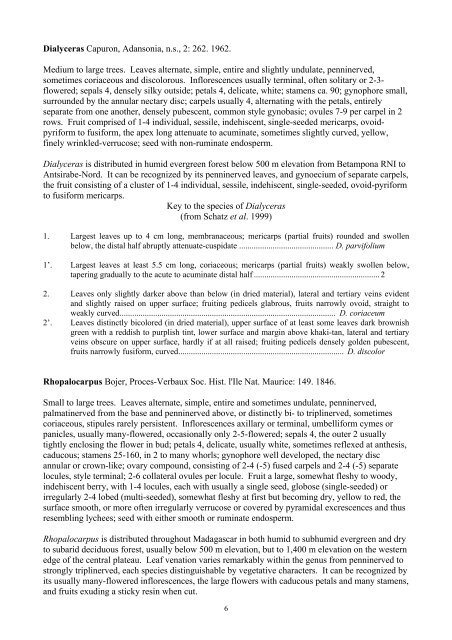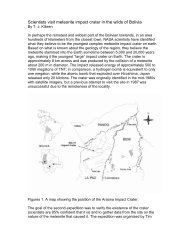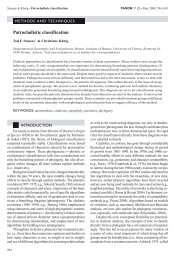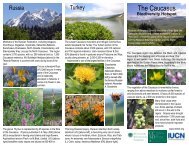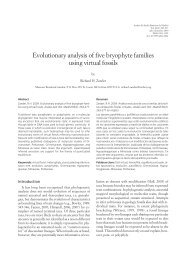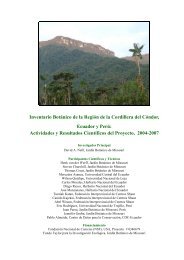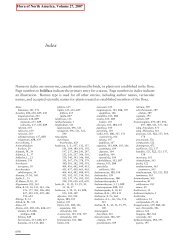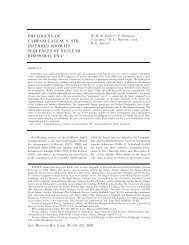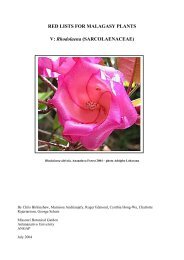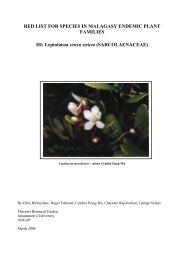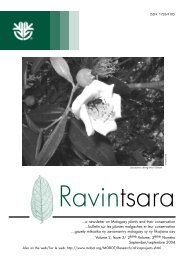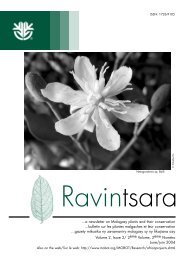red lists for malagasy plants iv: sphaerosepalaceae - Missouri ...
red lists for malagasy plants iv: sphaerosepalaceae - Missouri ...
red lists for malagasy plants iv: sphaerosepalaceae - Missouri ...
You also want an ePaper? Increase the reach of your titles
YUMPU automatically turns print PDFs into web optimized ePapers that Google loves.
Dialyceras Capuron, Adansonia, n.s., 2: 262. 1962.<br />
Medium to large trees. Leaves alternate, simple, entire and slightly undulate, penninerved,<br />
sometimes coriaceous and discolorous. Inflorescences usually terminal, often solitary or 2-3flowe<strong>red</strong>;<br />
sepals 4, densely silky outside; petals 4, delicate, white; stamens ca. 90; gynophore small,<br />
surrounded by the annular nectary disc; carpels usually 4, alternating with the petals, entirely<br />
separate from one another, densely pubescent, common style gynobasic; ovules 7-9 per carpel in 2<br />
rows. Fruit comprised of 1-4 ind<strong>iv</strong>idual, sessile, indehiscent, single-seeded mericarps, ovoidpyri<strong>for</strong>m<br />
to fusi<strong>for</strong>m, the apex long attenuate to acuminate, sometimes slightly curved, yellow,<br />
finely wrinkled-verrucose; seed with non-ruminate endosperm.<br />
Dialyceras is distributed in humid evergreen <strong>for</strong>est below 500 m elevation from Betampona RNI to<br />
Antsirabe-Nord. It can be recognized by its penninerved leaves, and gynoecium of separate carpels,<br />
the fruit consisting of a cluster of 1-4 ind<strong>iv</strong>idual, sessile, indehiscent, single-seeded, ovoid-pyri<strong>for</strong>m<br />
to fusi<strong>for</strong>m mericarps.<br />
Key to the species of Dialyceras<br />
(from Schatz et al. 1999)<br />
1. Largest leaves up to 4 cm long, membranaceous; mericarps (partial fruits) rounded and swollen<br />
below, the distal half abruptly attenuate-cuspidate ............................................. D. parvifolium<br />
1’. Largest leaves at least 5.5 cm long, coriaceous; mericarps (partial fruits) weakly swollen below,<br />
tapering gradually to the acute to acuminate distal half ............................................................ 2<br />
2. Leaves only slightly darker above than below (in dried material), lateral and tertiary veins evident<br />
and slightly raised on upper surface; fruiting pedicels glabrous, fruits narrowly ovoid, straight to<br />
weakly curved....................................................................................................... D. coriaceum<br />
2’. Leaves distinctly bicolo<strong>red</strong> (in dried material), upper surface of at least some leaves dark brownish<br />
green with a <strong>red</strong>dish to purplish tint, lower surface and margin above khaki-tan, lateral and tertiary<br />
veins obscure on upper surface, hardly if at all raised; fruiting pedicels densely golden pubescent,<br />
fruits narrowly fusi<strong>for</strong>m, curved............................................................................... D. discolor<br />
Rhopalocarpus Bojer, Proces-Verbaux Soc. Hist. l'Ile Nat. Maurice: 149. 1846.<br />
Small to large trees. Leaves alternate, simple, entire and sometimes undulate, penninerved,<br />
palmatinerved from the base and penninerved above, or distinctly bi- to triplinerved, sometimes<br />
coriaceous, stipules rarely persistent. Inflorescences axillary or terminal, umbelli<strong>for</strong>m cymes or<br />
panicles, usually many-flowe<strong>red</strong>, occasionally only 2-5-flowe<strong>red</strong>; sepals 4, the outer 2 usually<br />
tightly enclosing the flower in bud; petals 4, delicate, usually white, sometimes reflexed at anthesis,<br />
caducous; stamens 25-160, in 2 to many whorls; gynophore well developed, the nectary disc<br />
annular or crown-like; ovary compound, consisting of 2-4 (-5) fused carpels and 2-4 (-5) separate<br />
locules, style terminal; 2-6 collateral ovules per locule. Fruit a large, somewhat fleshy to woody,<br />
indehiscent berry, with 1-4 locules, each with usually a single seed, globose (single-seeded) or<br />
irregularly 2-4 lobed (multi-seeded), somewhat fleshy at first but becoming dry, yellow to <strong>red</strong>, the<br />
surface smooth, or more often irregularly verrucose or cove<strong>red</strong> by pyramidal excrescences and thus<br />
resembling lychees; seed with either smooth or ruminate endosperm.<br />
Rhopalocarpus is distributed throughout Madagascar in both humid to subhumid evergreen and dry<br />
to subarid deciduous <strong>for</strong>est, usually below 500 m elevation, but to 1,400 m elevation on the western<br />
edge of the central plateau. Leaf venation varies remarkably within the genus from penninerved to<br />
strongly triplinerved, each species distinguishable by vegetat<strong>iv</strong>e characters. It can be recognized by<br />
its usually many-flowe<strong>red</strong> inflorescences, the large flowers with caducous petals and many stamens,<br />
and fruits exuding a sticky resin when cut.<br />
6


